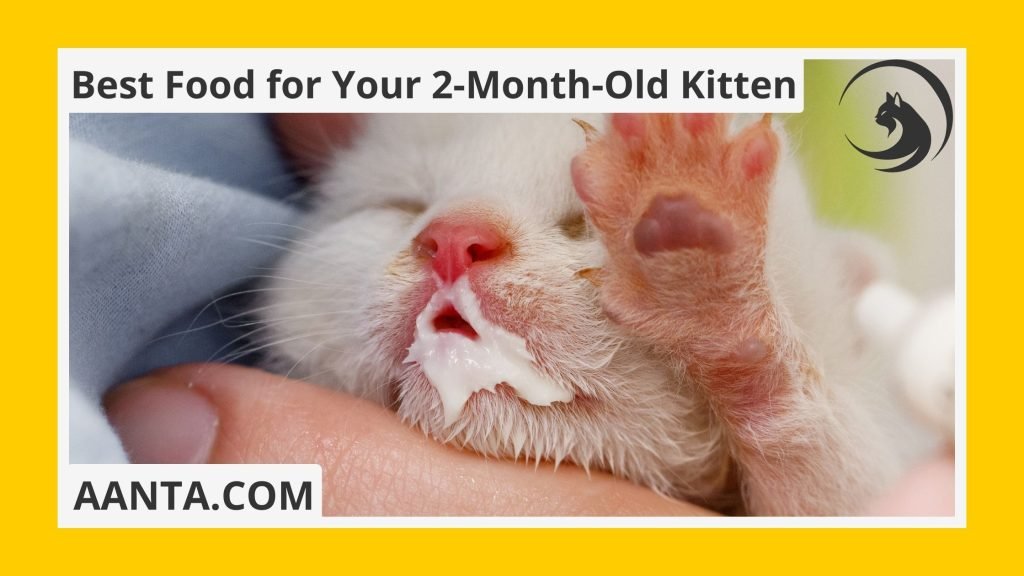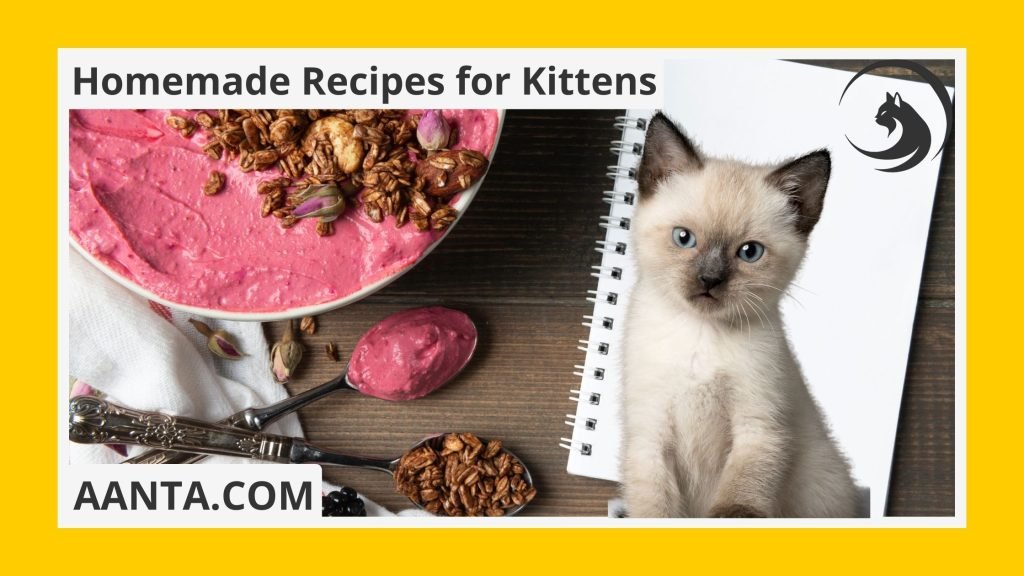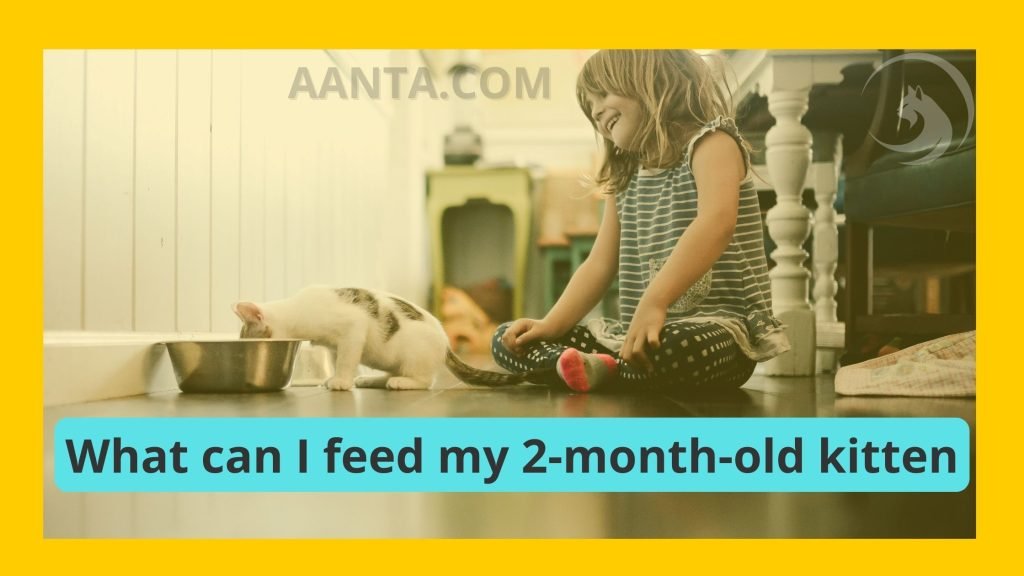Kittens enter the world with small stomachs, typically measuring just a few centimeters, yet their growth trajectory is rapid. However, the nourishment they require varies during their initial developmental phases. In this article, we aim to address two common queries among cat owners: How often should they feed their feline companions, and what amounts of dry or wet food are optimal?
Welcoming a new cat into your home is an exciting endeavor. However, for those without prior feline caregiving experience, it can pose challenges and necessitate a profound sense of responsibility. Ensuring your kitten receives proper nourishment is paramount for its robust growth and well-being. If you find yourself uncertain about the correct feeding regimen or portion sizes, fear not, as we’re here to provide insights into the best practices for nurturing your kitten.
Tips for Feeding Your Motherless 2-Month-Old Kitten

Here are five tips to ensure you’re nurturing your motherless kitten with care and expertise:
1. Prepare the replacement formula with precision:
- The milk should be Heat the milk to approximately 95°F (35°C) or body temperature, ensuring it’s comfortably warm for your kitten
- The formula should always be Mix the formula just before feeding, discarding any leftovers after 3 hours.
2. Hold your kitten securely during feeding:
Cradle the kitten horizontally, with its belly down and head slightly elevated.
Avoid feeding it while on its back to prevent fluid aspiration, mimicking how kittens feed from their mother
3. Exercise caution with feeding amounts:
Overfeeding is a common mistake, potentially affecting your kitten’s development. Follow guidelines carefully; a newborn typically nurses for 5 to 10 minutes per feeding, with no session exceeding 15 minutes. Start with 32 cc of formula daily, increasing gradually to 80 cc by week 3 and 100 cc by week 4.
4. Offer milk in small, manageable doses:
Use a syringe, dropper, or feeding bottle with a slow, steady flow. Guide the kitten’s mouth onto the nipple, ensuring it swallows properly.
- Check the flow from the bottle is slow and steady, as too much flow will cause the milk to come out of the kitten’s nose.
- If that happens, stop feeding immediately and give the cat a break for a few minutes. When you resume feeding, try to regulate the flow more carefully.
5. Introduce weaning gradually after 4 and a half weeks
Begin transitioning to wet food by adding small amounts to the formula, and gradually thickening the mixture. Offer “sludge” in a bottle to introduce meat flavors, then progress to feeding from a bowl. By seven to eight weeks, kittens can fully transition to wet food.
Choosing the Best Food for Your 2-Month-Old Kitten

Encouraging a balanced diet for kittens and adult cats involves incorporating both wet and dry food to maintain hydration levels. Beginning with tender kitten food is advisable as they progress through their initial months.
Opting for wet food over dry is preferred, with emphasis on selecting options with real meat as the primary ingredient rather than by-products or modified components. It’s essential to provide wet food at least once daily, along with ensuring access to sufficient water, even if in smaller quantities.
Introducing a diverse range of foods during a cat’s formative years can offer long-term benefits, potentially reducing the likelihood of dietary fixations or allergies. However, the gradual introduction of new meals is recommended.
While certain brands like Purina and Blue Buffalo are often touted in online discussions, I’ve found their quality lacking, particularly Blue Buffalo in recent assessments.
I stumbled upon some independent research findings which I thought might interest you. The study compiled various products, summarizing their recommendations based on a thorough analysis
Here are a few standout kitten food options from their research:
- Royal Canin Extra Soft Mousse for mother and baby cats
- Wellness core classic cat food
- Grain-free white fish halo recipe
Feeding Schedule for Your 2-Month-Old Kitten

Introducing solid foods into your 2-month-old kitten’s diet signifies a significant milestone in their growth. As they transition from nursing to self-sustained eating, establishing an appropriate feeding routine becomes paramount for their well-being and development. Understanding their nutritional needs and crafting a schedule tailored to their age ensures they receive the nourishment necessary for a healthy beginning.
Around the age of 8 weeks, kittens should be fully switched to solid cat food, coinciding with the commencement of their vaccination schedule as recommended by veterinarians. At two months old, feeding them twice daily with regular kitten food becomes essential. As they approach their first year, transitioning to adult cat food is typically advised, although consulting with your veterinarian is prudent.
For kittens, nursing from their mother, weaning usually occurs around 4 weeks, and the same timeline applies to bottle-fed kittens. Initially, mix wet cat food with a milk replacer to form a slurry mixture when introducing specially formulated cat food. During the fifth week, gradually incorporate small amounts of formula into the slurry and introduce dry cat food alongside a bowl of water.
Homemade Recipes for 2-Month-Old Kittens

Feeding your cat homemade food is a fantastic way to provide optimal nutrition. Not only is it more economical than purchasing commercial cat food, but it also offers superior nourishment. Crafting your meals ensures your feline friend receives all the essential vitamins and minerals.
Transitioning your kitten to homemade food requires careful consideration. Begin by gradually replacing store-bought food with homemade options over 2-3 weeks. This gradual transition minimizes the risk of digestive upset and helps your cat adjust to the new diet.
One of the simplest and most popular recipes for homemade kitten food includes:
- 1 egg yolk
- 1/3 cup cooked meat (chicken or beef)
- 1 tablespoon yogurt (plain or vanilla)
Blend these ingredients until smooth, then portion into ice cube trays and freeze overnight for a convenient serving.
When preparing homemade food for your 2-month-old kitten, ensure you have:
- High-quality meat sources like chicken or turkey breast (with reduced fat)
- Optional: a can of tuna
- Blender or food processor
- A small amount of rice or pasta (optional)
- Vegetables such as carrots and broccoli
Homemade cat food offers numerous benefits for your young kitten, including affordability and accessibility compared to store-bought treats. Additionally, it’s safer and less harmful than many commercial products on the market. In this guide, we’ll explore how to prepare homemade food for your cat, along with essential tips for starting this dietary regimen.
Making Sure Your Kitten Gets the Right Nutrients

Kittens have unique nutritional requirements distinct from adult cats, which evolve as they grow week by week. Ensuring they receive the appropriate nourishment is crucial for their well-being and contentment at every stage of development.
Consider these useful directives:
1. Avoid feeding your cat these items:
- Onion
- Chocolate
- Grapes and raisins
- Garlic
- Coffee and tea Additionally, exercise caution with the following foods, as they may harbor harmful bacteria, induce malabsorption disorders, or trigger stomach discomfort:
- Raw fish
- Unripe liver
- Cow milk
- Raw eggs Raising a thriving and joyful kitten demands diligence, but adhering to these guidelines simplifies the process.
2. Nutrition for kittens aged three to six months: Growth
Monitor your cat’s weight closely and furnish her with suitable sustenance. For kittens, provide specialized kitten formula or wet kitten food tailored to their preferences. Utilize feeding charts to adjust meal portions appropriately, typically around 1/3 cup three times daily. This regimen ensures your pet receives essential nutrients while averting the risk of obesity.
3. Feeding kittens aged five to eight weeks: Solid food
Once weaned from the bottle or mother, introduce the recommended solid, meat-based cat food enriched with vital growth nutrients. Adhere to these pointers:
- Since kittens have smaller stomachs, offer 3-4 small meals (approximately 1/4 cup) daily, accompanied by ample water.
- Opt for dry cat food with around 35% protein and 12-24% fat content.
- Begin with high-quality cat food from the outset. If necessitated, transition between brands gradually to prevent digestive disturbances.
- Place feeding bowls in a tranquil, stress-free area of the house.
SUMMARY
Newborn kittens begin with small stomachs no larger than a woman’s fingernail, but they grow quickly. You should know that their nutritional requirements vary during their stages of growth, and each stage has special requirements. Whether you’re wondering how often to feed your cat or how much wet versus dry food to give, everything you need to know is in this article.
Feeding tips for your kitten:
For those who are raising a 2-month-old motherless kitten, here are some tips to ensure your kitten is well-fed. From mixing the formula ingredients correctly to holding your cat during feeding time, every detail is important. Remember that small, frequent meals are the most important meals for her, especially in the first weeks.
Choose the appropriate food for the kitty:
When it comes to choosing what is best for your Robert-aged cat, it’s a balance of nourishing, dry, and moisturizing. Choose products that contain prime meat as the primary ingredient and get your cat the nutrition it needs to fully thrive.
Wrapping Up:
Raising a happy, healthy cat takes a little dedication, but with knowledge and proper care, you will notice your cat turning into a cheerful, energetic cat. If you need more tips or advice, we are here to help you every step of the way because we always provide the latest articles about kittens.
CONCLUSION
Caring for kittens brings joy and fulfillment to cat enthusiasts. By understanding their nutritional requirements and following the advice of experienced cat lovers on feeding schedules and dietary choices, you ensure optimal growth and well-being for your feline companion.
Bear in mind that each cuddle, every meal provided, and each playful moment foster a deeper connection between you and your cat. Embrace the journey with love and patience, minimizing stressors, for cats, like any sentient being, thrive in an environment of understanding and care.
FAQS
1. How often should I feed my 2-month-old motherless kitten?
- For a 2-month-old motherless kitten, it’s crucial to feed them small, frequent meals. Typically, they should be fed every 5 to 6 hours, totaling around 6 to 8 feedings per day.
2. What should I consider when preparing the replacement formula for my kitten?
- When preparing the replacement formula, ensure the milk is warmed to approximately 95°F (35°C) or body temperature. It’s essential to mix the formula just before feeding and discard any leftovers after 3 hours.
3. What’s the best way to hold my kitten during feeding?
- Hold your kitten securely by cradling them horizontally, with their belly down and head slightly elevated. Avoid feeding them while they’re on their back to prevent fluid aspiration, mimicking how kittens feed from their mother.
4. How much formula should I feed my kitten, and how do I know if I’m overfeeding?
- Follow feeding guidelines carefully, as overfeeding can impact your kitten’s development. A newborn typically nurses for 5 to 10 minutes per feeding, with no session exceeding 15 minutes. Start with 32 cc of formula daily, gradually increasing to 80 cc by week 3 and 100 cc by week 4.
5. When should I start weaning my kitten, and how should I introduce solid foods?
- Weaning should begin gradually after around 4 and a half weeks. Start by introducing wet food alongside the formula, gradually thickening the mixture. By seven to eight weeks, kittens can transition fully to wet food.
6. What type of food is best for my 2-month-old kitten?
- Opt for wet food over dry, with real meat as the primary ingredient. It’s essential to provide wet food at least once daily and ensure access to sufficient water. Gradually introduce a diverse range of foods to prevent dietary fixations or allergies.
7. How should I transition my kitten to solid foods, and what’s an appropriate feeding schedule?
- Transition to solid foods should occur around 8 weeks of age. Feed your kitten twice daily with regular kitten food, gradually transitioning to adult cat food as advised by your veterinarian.
8. Can I feed my kitten homemade food, and what are some simple recipes?
- Homemade food can provide optimal nutrition for kittens. A simple recipe includes 1 egg yolk, 1/3 cup cooked meat (chicken or beef), and 1 tablespoon yogurt (plain or vanilla). Blend these ingredients and freeze them in ice cube trays for convenient serving.
9. What nutrients should I ensure my kitten receives for optimal growth and health?
- Kittens have unique nutritional requirements, so it’s essential to provide a balanced diet. Avoid feeding them harmful items like onion, chocolate, grapes, and raisins. Focus on providing high-quality protein and fat content suitable for their growth stage.
10. How can I monitor my kitten’s growth and adjust their diet accordingly?
- Monitor your kitten’s weight closely and adjust meal portions based on feeding charts. Provide specialized kitten formula or wet kitten food tailored to their preferences, ensuring they receive essential nutrients without risking obesity.







